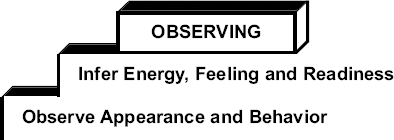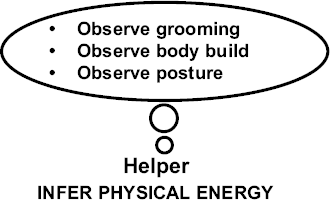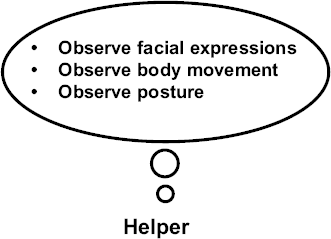Observing skills are the most basic helping skills. They are a rich source of learning about the helpees. When all else fails, we emphasize observing our helpees. We learn much of what we need to know about people by observing them.
Observing skills involve the helper’s ability to see and to understand the nonverbal behavior of the helpee. We must observe those aspects of the helpee’s appearance and behavior which help us to infer the helpee’s physical energy level, emotional feeling state and intellectual readiness for helping. These references are the bases for our initial understanding of where the helpee is coming from.

OBSERVING
When we observe we collect the nonverbal information that the helpees present to us. We learn about the helpees by noting their appearance, specifically their posture, body build and grooming. We can also collect information by observing their behaviors, specifically their facial expressions and body movements.
From their appearance and behaviors, we can make some inferences about their energy level, feeling state and readiness for helping.

OBSERVING APPEARANCE AND BEHAVIOR
Energy level is the amount of physical effort put into purposeful tasks. Knowing how long people can sustain high levels of functioning is essential to knowing how people experience their lives. Only people with high energy levels can experience the fullness of life. Persons with low energy levels have great difficulty in meeting even the simplest demands of everyday life.
The richest source of information about energy level is communicated by the alertness of the helpee’s posture. Specifically, the helper will look for the same cues in the helpee that were discussed earlier in helper attending: the extent to which the helpee stands and sits erect or leans forward with eyes focused on the helper. A helpee who sits slouched with shoulders drooped is taking a position that suggests low energy.
Energy level may also be expressed in body build. For example, helpees who are physically overweight or underweight or have poor muscle tone will tend to have low levels of energy. Cues to the helpee’s energy level can also be observed in grooming and nonverbal expressions. It takes a certain amount of energy to maintain a clean and neat appearance.
In addition to gathering information from appearance, helpee energy level can be inferred from helpee behavior. For example, slow helpee body movements may infer a low level

Facial expressions are the richest source of data concerning the helpee’s feelings. Other areas, especially posture, also contribute to understanding the helpee’s experience. Inferences can also be made based on body movements, with slow movements indicating “down” feelings and overly swift movements suggesting tension or anxiety. From this data we can infer the helpee’s emotional feeling state. For example, a deep furrowed brow, a frown, a slouched posture, downcast eyes, poor grooming and slow body movements all communicate “down” feelings. A broad smile, raised eyebrows, an attending posture, eye contact, careful grooming and quick responsive body movements are associated with “up” feelings.

INFER EMOTIONAL FEELING STATE
From our observations of helpee appearance and behavior, we may infer their general intellectual readiness for helping. Again, helpee posture is the most powerful cue to readiness for involvement in helping. We can also learn about the helpee’s readiness by observing body movements and facial expressions. A helpee who has a low energy level and “down” feelings will usually have a low readiness for helping, whereas a helpee with high energy and “up” feelings is usually ready for the helping process.

INFER INTELLECTUAL READINESS FOR HELPING
By observing we can gain valuable information about the helpees’ experiences. One way of structuring observing is to observe the helpees for precisely the same attending posture that we exhibit as helpers. Based upon our observations of appearance and behavior, we can make inferences about the helpees’ functioning. We can infer a helpee’s physical energy level, emotional feeling state and intellectual readiness for helping.
It is important to remember that observations must be considered hypotheses to be confirmed or denied over time by the helpees’ behavioral and verbal expressions. Observations should not be taken as a valid basis for making snap judgments about a person.
INFERRING FROM OBSERVATIONS
Perhaps one of the most important aims of observation is identifying discrepancies or incongruencies in people’s behavior or appearance. Being incongruent simply means that people are not consistent in their behavior or appearance. For example, people may be sitting slumped, looking at the floor and fidgeting, yet say they feel fine.
Being incongruent is itself a critical sign of people in trouble. Helpees invariably want to become more positively congruent. Perhaps the most important aspect of behavior to which you can respond initially is the helpees’ desire to get themselves “together.” More than anything else in the world, the helpees want to be able to function effectively without those glaring inconsistencies in their actions.

OBSERVING INCONGRUENCIES
We can observe ourselves in the same manner that we observe others. What does our appearance and behavior say about us? Do we project a high level of energy, feeling and readiness to help? Are we congruent in our behavior and our expressed desire to help?
We can also use our observations of ourselves and our helpees to involve the helpees. In helping, we should be focusing our entire beings upon the helpees and their expressions of their experiences. In this manner, we are communicating nonverbally that we are attending to them and that our interest is focused upon their experiences of themselves. In so doing, we increase the helpees’ sense of comfort and security in helping.
OBSERVING OURSELVES
